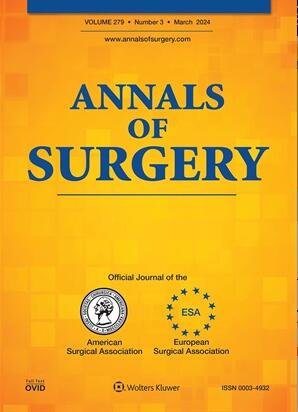随机对照试验-胃肠肿瘤(GI)手术患者生成健康数据的围手术期远程监测:评估结果
IF 7.5
1区 医学
Q1 SURGERY
引用次数: 0
摘要
目的确定围手术期监护与护理分诊干预是否可行,并改善手术效果和康复。背景复杂的胃肠道肿瘤手术后门诊康复的需求增加,同时期望改善生活质量和加快功能恢复。远程监控是实现这些目标的一种机制。方法该前瞻性随机对照试验于2021年10月至2023年7月在一所机构进行,随访于2023年8月完成。接受胃肠道肿瘤手术的成年患者被随机分配到远程监测干预组或强化常规护理对照组。在出院、出院后2天、7天、14天和30天对患者产生的健康数据(PGHD)和电子患者报告结果(ePROs)进行评估。当PGHD偏离定义的阈值时,远程监测干预组还接受护理分诊支持。结果129名参与者(中位[IQR]年龄,53 [47-65];43%为女性)。50人(39%)住在离医疗中心50英里的地方。总体流失率为12%,两组之间在可行性、保留率或可接受性方面没有差异。两组术后并发症和再入院率相似。与对照组相比,干预组在多个时间点的MD安德森症状量表(MDASI)对活动和症状严重程度评分的干扰显著降低(P<0.05)。结论围手术期远程监护是可行和可接受的。干预组ePROs的改善表明,护理分诊干预可能有助于增强术后恢复。本文章由计算机程序翻译,如有差异,请以英文原文为准。
Randomized Controlled Trial - Perioperative Telemonitoring of Patient Generated Health Data in Gastrointestinal Oncologic (GI) Surgery: Assessing Outcomes.
OBJECTIVE
To determine whether perioperative monitoring with nursing triage intervention is feasible and improves surgical outcomes and recovery.
BACKGROUND
There are increased demands for outpatient recovery after complex gastrointestinal oncologic surgery with simultaneous expectations of improving quality of life and expedited functional recovery. Telemonitoring is a proposed mechanism to achieve these goals.
METHODS
This prospective randomized controlled trial was conducted at a single institution from October 2021 to July 2023, and follow-up was completed in August 2023. Adult patients undergoing gastrointestinal oncologic surgery were randomized to either the telemonitoring intervention arm or the enhanced usual care control arm. Patient-generated health data (PGHD) and electronic patient-reported outcomes (ePROs) were assessed at discharge, 2 days, 7 days, 14 days, and 30 days post-discharge. The telemonitoring intervention arm additionally received nursing triage support when PGHD deviated from defined thresholds.
RESULTS
129 participants (median [IQR] age, 53 [47-65]; 43% female) were randomized. 50 (39%) lived >50 miles from the medical center. Overall attrition was 12%, and there were no differences in feasibility, retention, or acceptability between arms. Postoperative complications and readmission rates were similar between arms. The intervention arm reported significantly lower MD Anderson Symptom Inventory (MDASI) interference with activity and symptom severity scores at multiple time points compared to the control arm (P<0.05).
CONCLUSIONS
This trial demonstrates that perioperative telemonitoring is feasible and acceptable. Improved ePROs in the intervention arm suggests that nursing triage intervention may help augment postoperative recovery.
求助全文
通过发布文献求助,成功后即可免费获取论文全文。
去求助
来源期刊

Annals of surgery
医学-外科
CiteScore
14.40
自引率
4.40%
发文量
687
审稿时长
4 months
期刊介绍:
The Annals of Surgery is a renowned surgery journal, recognized globally for its extensive scholarly references. It serves as a valuable resource for the international medical community by disseminating knowledge regarding important developments in surgical science and practice. Surgeons regularly turn to the Annals of Surgery to stay updated on innovative practices and techniques. The journal also offers special editorial features such as "Advances in Surgical Technique," offering timely coverage of ongoing clinical issues. Additionally, the journal publishes monthly review articles that address the latest concerns in surgical practice.
 求助内容:
求助内容: 应助结果提醒方式:
应助结果提醒方式:


